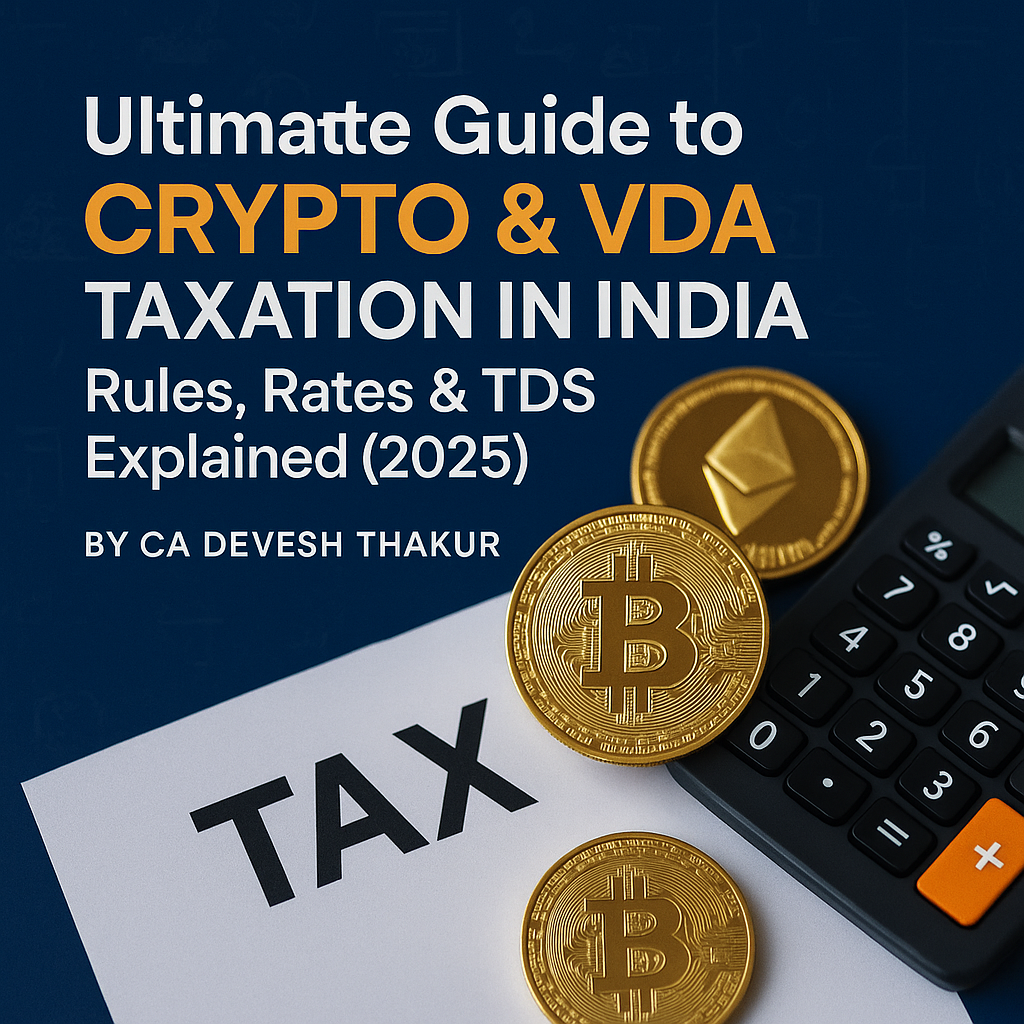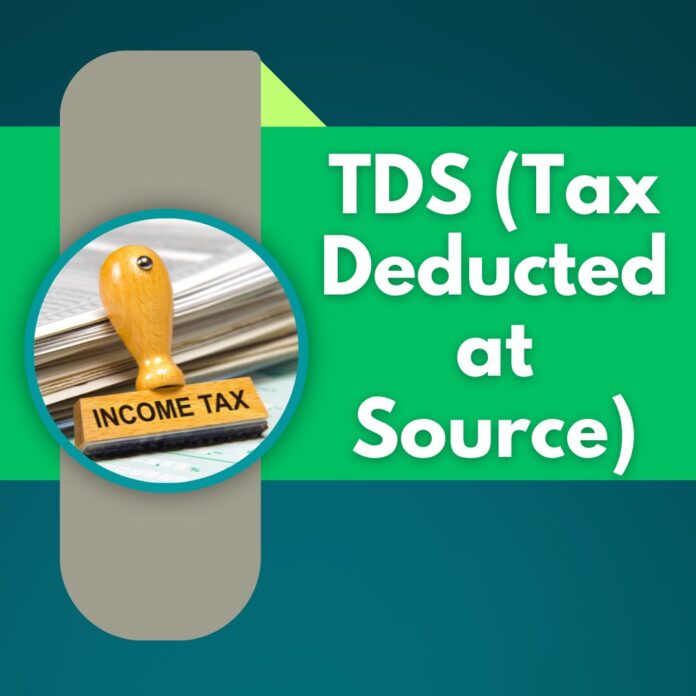India’s Taxation of Virtual Digital Assets (VDAs): A Detailed Briefing
This briefing document summarizes key aspects of Virtual Digital Asset (VDA) taxation in India, drawing from the provided “Taxation on VDAs in India.pdf” excerpts. It highlights definitions, tax rates, deductions, reporting requirements, and specific scenarios like mining, staking, and airdrops.
I. Definition and Scope of VDAs
India’s tax framework broadly defines VDAs under Section 2(47A) to include:
- Cryptocurrencies
- Non-Fungible Tokens (NFTs)
- Other digital tokens Crucially, this definition excludes fiat currency, gift cards, and vouchers, clearly distinguishing VDAs from traditional financial instruments and gift mechanisms.
II. Core Taxation Principles
The taxation of VDAs in India is characterized by a high, flat tax rate and stringent limitations on deductions and loss adjustments.
- Flat Tax Rate on Gains: A significant feature is the flat 30% tax rate (plus 4% cess) applied to all types of gains from VDA transactions. This rate applies irrespective of whether the gains are considered short-term or long-term.
- Limited Allowable Deductions: Taxpayers can only deduct the cost of acquisition when calculating VDA gains. “No other expense allowed,” meaning common business or investment expenses (e.g., trading fees, software costs) cannot be set off against VDA income.
- No Loss Adjustment: A particularly restrictive rule states that losses from VDA transactions are “Not allowed; cannot set off losses against any other income.” This implies that VDA losses cannot be carried forward or offset against gains from other income sources, nor even against other VDA gains.
III. Income Head Classification and Reporting
VDA income can fall under various income heads depending on the nature of the activity:
- Capital Gains: For VDAs held as investments.
- Business Income: For individuals engaged in “frequent trading” of VDAs.
- Income from Other Sources: Specifically for “airdrops/gifts.”
All VDA-related income and transactions must be reported using Schedule VDA in the Income Tax Return (ITR).
IV. Specific VDA Activities and Their Tax Implications
The tax framework addresses various ways VDAs can be acquired and generated:
- Crypto Mining Income: This income is “Taxed at 30%,” with the “acquisition cost considered zero.” This means the entire fair market value of mined crypto is treated as taxable income.
- Crypto Staking Income: Also “Taxed at 30%.” The “cost of acquisition = amount taxed earlier,” implying that the value taxed upon receipt from staking then becomes the base cost for future sale calculations.
- Airdrop Tax: Airdrops are taxed at “30% on FMV at receipt.” Similar to staking, the “FMV becomes acquisition cost for future sale,” preventing double taxation on the initial value.
- Illustrative Example: “If Bob gets 20,000 tokens (FMV ₹10) as airdrop = ₹2,00,000 income → taxed at 30%.” If he later “Sells airdrop later at ₹5,00,000 → gain = ₹3,00,000 → taxed at 30% again,” this shows the two-stage taxation.
- Crypto Gift Tax: Gifts of VDAs are “Taxable under ‘Income from Other Sources’ if value > ₹50,000 from non-relative.”
- Exemptions: Gifts “Received from relatives or on special occasions like marriage, inheritance” are exempt.
V. Tax Deducted at Source (TDS) – Section 194S
A critical component of VDA taxation is the TDS mechanism, designed to ensure tax collection at the source of transactions.
- TDS Rate: 1% of the sale consideration.
- TDS Thresholds: Applicable if the yearly value of transactions “greater than ₹50,000 (₹10,000 in some cases).”
- The “₹50,000/year” threshold applies to “specified persons,” while “₹10,000/year” applies to “others.”
- Specified Person for TDS Relief: An “Individual/HUF with turnover < ₹1 Cr (business) or < ₹50 Lakh (profession) in previous FY” is considered a “specified person” and benefits from the higher TDS threshold.
- No TAN Requirement for Specified Persons: “For ‘specified persons’, TAN not required under Sec 203A,” simplifying compliance for smaller taxpayers.
- TDS for Non-Cash Transactions: If a VDA is received “in kind,” the “Buyer pays TDS from own funds.” This addresses barter-like VDA exchanges.
- TDS Exceptions: Notably, TDS “Not applicable to DEX/international exchange transactions,” posing a challenge for enforcement on decentralized or foreign platforms.
VI. Transactions Subject to Tax
The scope of “Crypto Transactions Taxed” is broad, encompassing various activities:
- Buying
- Selling
- Exchanging
- Mining
- Receiving salary in VDA
- Staking
- Airdrops
VII. Compliance and Bookkeeping
- Crypto Bookkeeping: The document recommends using “crypto accounting tools for reports, classification, closing balance checks,” highlighting the complexity of tracking VDA transactions for tax purposes.
- Tax Calculation Example: The basic calculation involves “Sale Price – Purchase Price = Gain → 30% tax on gain.”
In summary, India’s VDA tax regime is characterized by a high, flat tax rate, minimal deductions, strict rules on loss adjustments, and a comprehensive TDS mechanism. It aims to bring a wide range of VDA activities under the tax net, albeit with specific exemptions and compliance nuances.
What is a Virtual Digital Asset (VDA) in India, and what types of assets does it include?
In India, a Virtual Digital Asset (VDA) is broadly defined to include cryptocurrencies, Non-Fungible Tokens (NFTs), and other similar tokens. This definition specifically excludes fiat currency, gift cards, and vouchers. Essentially, it covers most digital assets that are not traditional forms of money or pre-paid value instruments.
What is the standard tax rate for gains from VDAs, and are there any additional charges?
Gains derived from VDAs in India are subject to a flat tax rate of 30%. In addition to this, a 4% cess is applied, meaning the effective tax rate is slightly higher than 30%. This flat rate applies uniformly to all types of gains, whether they are classified as short-term or long-term.
What deductions are allowed when calculating tax on VDA gains?
When calculating the taxable gain from VDAs, the only allowable deduction is the cost of acquisition of the VDA. No other expenses, such as trading fees, internet costs, or professional advice fees, can be deducted from the gains.
How are losses from VDA transactions treated for tax purposes?
Losses incurred from VDA transactions are generally not allowed to be adjusted. This means that a taxpayer cannot set off losses from VDA sales against any other income, nor can they carry forward these losses to future assessment years.
What are the rules for Tax Deducted at Source (TDS) on VDA transactions?
A 1% TDS is applicable on the sale consideration of VDAs if the yearly value exceeds ₹50,000 (or ₹10,000 in some specific cases). This applies to buying, selling, and exchanging VDAs. However, TDS provisions are not applicable to transactions conducted on Decentralized Exchanges (DEXs) or international exchanges. For non-cash transactions where VDAs are received in kind, the buyer is responsible for paying the TDS from their own funds.
How is income from crypto mining, staking, and airdrops taxed in India?
Income from crypto mining is taxed at a 30% rate, with the acquisition cost of the mined assets considered zero for tax purposes. For crypto staking income, it is also taxed at 30%, and the amount previously taxed becomes the acquisition cost for any future sale. Airdrops are taxed at 30% on their Fair Market Value (FMV) at the time of receipt, and this FMV then becomes the acquisition cost for subsequent sales of those airdropped assets.
Under which income heads should VDA-related income be reported in India?
VDA-related income can fall under different income heads depending on the nature of the activity. If VDAs are held as investments, the gains are reported under ‘Capital Gains’. For individuals engaged in frequent trading, it may be classified as ‘Business Income’. Income from sources like airdrops and gifts (if exceeding ₹50,000 from a non-relative) falls under ‘Income from Other Sources’. Taxpayers are required to use Schedule VDA in their Income Tax Returns (ITR) to report these transactions.
Are there any exemptions for VDA gifts, and what are the TDS thresholds for individuals?
Gifts of VDAs are generally taxable under ‘Income from Other Sources’ if their value exceeds ₹50,000 and they are received from a non-relative. However, gifts received from relatives or on special occasions like marriage or inheritance are exempt from tax. For TDS purposes, a ‘specified person’ (an individual or HUF with a business turnover less than ₹1 Cr or professional receipts less than ₹50 Lakh in the previous FY) has a higher annual TDS threshold of ₹50,000, while for others, the threshold is ₹10,000. Specified persons are also exempt from the requirement of a Tax Deduction Account Number (TAN) under Section 203A.
This study guide is designed to help you understand the key aspects of VDA taxation in India, based on the provided source material.
1. Definition and Scope of VDAs: * What constitutes a Virtual Digital Asset (VDA) as per Section 2(47A)? * What assets are specifically excluded from this definition?
2. Tax Rates and Deductions: * What is the flat tax rate on gains from VDAs, including cess? * What is the only allowable deduction when calculating VDA gains? * What expenses are explicitly disallowed?
3. Tax Deducted at Source (TDS) – Section 194S: * What is the TDS rate on VDA sale consideration? * What are the annual thresholds for TDS applicability for different categories of individuals? * Who is considered a ‘specified person’ for TDS relief and what are their specific exemptions/reliefs? * How is TDS handled in non-cash VDA transactions? * Are there any exceptions to TDS applicability for certain types of exchanges? * Is a TAN (Tax Deduction and Collection Account Number) required for ‘specified persons’ under Section 203A?
4. Loss Adjustment and Set-off: * Can losses from VDA transactions be set off against other income? * Can VDA losses be carried forward to future assessment years? (Implicitly answered by “Not allowed”)
5. Income Head Classification and Reporting: * Under which income heads can VDA income be classified, depending on the nature of the activity? Provide examples for each. * Which specific schedule in the Income Tax Return (ITR) is used for reporting VDA income?
6. Specific VDA Income Scenarios: * How is income from crypto mining taxed, and what is considered its acquisition cost? * How is income from crypto staking taxed, and how is its acquisition cost determined for future sale? * How are airdrops taxed upon receipt, and what becomes their acquisition cost for subsequent sales? * List the various types of crypto transactions that are subject to taxation.
7. Crypto Gift Tax: * Under what circumstances are crypto gifts taxable? * What is the threshold for taxability from non-relatives? * Are there any exemptions for crypto gifts?
8. Bookkeeping and Compliance: * What is recommended for effective crypto bookkeeping?
II. Quiz
Instructions: Answer each question in 2-3 sentences.
- Define a Virtual Digital Asset (VDA) as per the provided information, and list one type of asset specifically excluded.
- What is the standard tax rate applied to gains from VDA transactions in India, and what additional cess is applicable?
- Explain the only allowable deduction when calculating gains from VDA sales and specify what expenses are expressly disallowed.
- Describe the Tax Deducted at Source (TDS) applicability for VDA transactions, including the general rate and one of the annual thresholds.
- Can losses incurred from VDA transactions be offset against other income sources? Explain briefly.
- Under what income head would frequent trading of VDAs typically be classified, and how does this differ from income derived from long-term investments?
- How is income from crypto mining taxed, and what is the deemed acquisition cost for such income?
- Explain how airdrops are taxed upon receipt and what value is then considered their acquisition cost for any future sale.
- List two scenarios where gifts of VDAs would be exempt from taxation.
- If a VDA transaction involves a non-cash payment, who is responsible for paying the TDS according to the provided guidelines?
III. Answer Key
- A VDA (Virtual Digital Asset) includes cryptocurrencies, NFTs, and tokens, but specifically excludes fiat currency, gift cards, and vouchers. This broad definition covers most digital assets that are not traditional money or specific pre-paid instruments.
- The standard tax rate on gains from VDA transactions is a flat 30%. Additionally, a 4% cess is applicable on this tax, effectively increasing the overall tax liability on VDA gains.
- The only allowable deduction when calculating gains from VDA sales is the cost of acquisition. No other expenses, such as trading fees, internet charges, or operational costs, are permitted to reduce the taxable gain.
- TDS is applicable at 1% of the sale consideration for VDA transactions. The annual threshold for TDS is ₹50,000 for specified persons and ₹10,000 for others, meaning transactions above these values trigger the TDS requirement.
- No, losses incurred from VDA transactions cannot be set off against any other income source in India. Furthermore, these losses are also not allowed to be carried forward to subsequent financial years.
- Frequent trading of VDAs would typically be classified under ‘Business Income’ due to the regularity and intent of profit-making. In contrast, long-term investments in VDAs are generally classified under ‘Capital Gains’.
- Income from crypto mining is taxed at a flat 30%. The acquisition cost for such mined crypto is considered zero, meaning the entire fair market value at the time of receipt is treated as taxable income.
- Airdrops are taxed at 30% on their Fair Market Value (FMV) at the time of receipt. This FMV then becomes the acquisition cost for that VDA for any future sale, which helps in calculating future gains or losses.
- Gifts of VDAs are exempt from taxation if they are received from relatives. They are also exempt if received on special occasions such as marriage or through inheritance, regardless of the sender.
- If a VDA transaction involves a non-cash payment (i.e., VDA is received in kind), the buyer is responsible for paying the TDS from their own funds. This ensures the TDS obligation is met even without a monetary sale consideration.
IV. Essay Format Questions
- Discuss the implications of the “no loss adjustment” rule for VDA taxation in India. How does this rule affect investor behavior and portfolio management compared to other asset classes?
- Analyze the rationale behind the distinct tax treatment of various VDA income streams (e.g., mining, staking, airdrops, trading). Do these classifications adequately capture the economic realities of each activity?
- Critically evaluate the effectiveness of the TDS mechanism (Section 194S) for VDAs in India. Consider its impact on compliance, liquidity, and the overall VDA ecosystem.
- Compare and contrast the taxation of VDAs with traditional financial assets (e.g., stocks, mutual funds) in India, focusing on aspects like tax rates, allowable deductions, and loss set-off rules. What are the key differences and their potential impact on investment decisions?
- Given the evolving nature of Virtual Digital Assets, what potential challenges might the current tax framework face in the future, and what policy adjustments might be necessary to address them?
V. Glossary of Key Terms
- Virtual Digital Asset (VDA): As per Section 2(47A), includes any information or code or number or token generated through cryptographic means or otherwise, by whatever name called, providing a digital representation of value exchanged with or without consideration, with the promise or expectation of a digital representation of value having inherent value, or a store of value or a unit of account and includes NFTs and any other token of similar nature, but excludes Indian currency or foreign currency, gift cards, or vouchers.
- Cess: An additional tax levied by the government to raise funds for a specific purpose, applied on top of the base tax rate (e.g., 4% cess on VDA tax).
- Cost of Acquisition: The original price paid to acquire an asset. In VDA taxation, this is generally the only allowable deduction.
- Fair Market Value (FMV): The price at which an asset would change hands between a willing buyer and a willing seller, neither being under any compulsion to buy or sell, and both having reasonable knowledge of relevant facts.
- Income from Other Sources: A residual head of income under Indian tax law that includes any income not specifically classified under other heads like salaries, house property, business or profession, or capital gains. Crypto gifts from non-relatives often fall here.
- Indian Tax Return (ITR): The form used by individuals and entities to declare their income and pay taxes to the Government of India.
- Non-Relative: For the purpose of gift tax, typically defined by tax laws to exclude certain close family members (e.g., spouse, siblings, lineal ascendants/descendants). Gifts from non-relatives above a certain threshold are taxable.
- Schedule VDA: A specific section or schedule within the Income Tax Return (ITR) form designated for reporting income and transactions related to Virtual Digital Assets.
- Specified Person (for TDS Relief): An individual or Hindu Undivided Family (HUF) whose total sales, gross receipts, or turnover from business is less than ₹1 Crore, or from a profession is less than ₹50 Lakh, in the previous financial year. They have different TDS thresholds and no TAN requirement.
- Tax Deduction and Collection Account Number (TAN): A ten-digit alphanumeric number issued by the Income Tax Department, mandatory for all persons responsible for deducting or collecting tax at source.
- Tax Deducted at Source (TDS): A mechanism where a portion of income is deducted as tax at the point of payment itself. For VDAs, 1% of the sale consideration is deducted.




